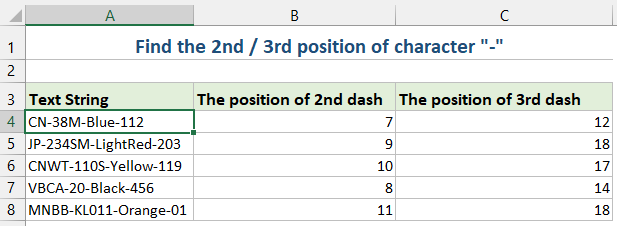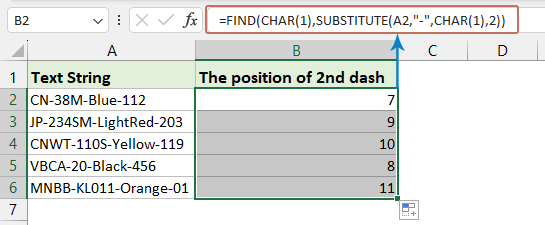Find den n. forekomst af et tegn i Excel – 3 hurtige måder
At finde den n'te forekomst af et bestemt tegn i en tekststreng i Excel kan være særligt nyttigt i dataanalyse, hvor du muligvis skal parse strenge eller udtrække information baseret på bestemte afgrænsningstegn eller mønstre. Lad os f.eks. finde den 2. eller 3. forekomst af tegnet "-" i en tekststreng. Jeg vil demonstrere enkle teknikker til effektivt at udføre denne opgave.

Find den n'te forekomst af et tegn i tekststrengen med formel
Du kan lave en formel for at finde den n'te forekomst af et tegn. Gør venligst som dette:
1. Indtast eller kopier følgende formel ind i en celle, hvor du vil have resultatet:
=FIND(CHAR(1),SUBSTITUTE(A2,"-",CHAR(1),2))- A2: Cellen, der indeholder strengen.
- -: Den karakter du leder efter.
- 2: Den anden forekomst, du vil finde, kan du ændre den til 2 ... efter behov.
2. Træk derefter formelfyldet ned for at udfylde formlen til andre celler, og tegnets 2. position – vises på én gang, se skærmbillede:
- ERSTATNING erstatter den n'te forekomst af tegnet med et tegn, der ikke kan udskrives (CHAR(1)).
- FIND søger efter dette ikke-udskrivbare tegn, hvilket giver positionen for den n'te forekomst.
Find n'te forekomst af et tegn i tekststreng med Kutools til Excel
Hvis du ikke er fan af at bruge formel eller VBA, kan du overveje et praktisk alternativ – Kutools til Excel. Inden for dets Formel-grupper finder du et nyttigt værktøj – Find hvor tegnet vises Nth i en streng som hurtigt identificerer og returnerer den n'te position af ethvert tegn i en celle.
Efter installation af Kutools til Excelklik Kutools > Formelhjælper > Formelhjælper at åbne Formelhjælper dialog boks. Klik på en celle, hvor du vil placere resultatet. Gør derefter som følger:
- Type Opslag fra rullelisten over Formeltype afsnit;
- Vælg Find hvor tegnet vises Nth i en streng in Vælg en formel afsnit;
- Vælg den celle, der indeholder den streng, du bruger, og skriv derefter det angivne tegn og den n'te forekomst i tekstboksene i Argumenter input afsnit;
- Endelig skal du klikke på OK knappen for at få resultatet.

Find n'te forekomst af et tegn i tekststrengl med brugerdefineret funktion
I dette afsnit vil vi undersøge, hvordan du opretter og bruger en UDF til at finde den n'te forekomst af et tegn i Excel, og giver en trin-for-trin guide til at hjælpe dig med at optimere din datahåndtering.
- Hold nede i ALT + F11 tasterne, og det åbner Microsoft Visual Basic til applikationer vindue.
- Klik indsatte > Moduler, og indsæt følgende makro i modulvinduet.
Function FindN(sFindWhat As String, _ sInputString As String, N As Integer) As Integer 'Updateby Extendoffice Dim J As Integer Application.Volatile FindN = 0 For J = 1 To N FindN = InStr(FindN + 1, sInputString, sFindWhat) If FindN = 0 Then Exit For Next End Function - Luk derefter vba-vinduet. Gå tilbage til regnearket, indtast følgende formel i en celle, og træk derefter udfyldningshåndtaget ned for at udfylde formlen til andre celler, se skærmbillede:
=FindN("-",A2,3)
- Tæl antallet af forekomster af et ord i en kolonne
- Hvis du har en kolonnedata, der indeholder nogle duplikatværdier som vist nedenfor, og hvad du nu vil gøre, er at tælle antallet af forekomster af et bestemt ord i denne kolonne. Nu med denne vejledning introducerer jeg nogle tricks til at løse det hurtigt i Excel.
- Erstat første n tegn eller n'te forekomst af tegn med et andet
- I Excel finder og erstatter vi normalt en streng med funktionen Find og erstat, men hvis du er i et af nedenstående tilfælde, kan funktionen Find og erstat ikke hjælpe dig.
- Udtræk et n'te tegn fra en streng
- Generelt vil du måske udtrække streng efter et bestemt tegn, men i dette tilfælde vil jeg udtrække det n'te tegn fra en streng som vist nedenfor.
- Udtræk første/sidste n tegn fra streng
- For eksempel er der en liste med lange strenge i hver celle, og du vil kun udtrække de første n tegn fra hver streng, ligesom de første 3 tegn i hver streng, og nu kan du bruge følgende metoder til at løse det i Excel .
Relaterede artikler:
Bedste kontorproduktivitetsværktøjer
Overlad dine Excel-færdigheder med Kutools til Excel, og oplev effektivitet som aldrig før. Kutools til Excel tilbyder over 300 avancerede funktioner for at øge produktiviteten og spare tid. Klik her for at få den funktion, du har mest brug for...

Fanen Office bringer en grænseflade til et kontor med Office, og gør dit arbejde meget lettere
- Aktiver redigering og læsning af faner i Word, Excel, PowerPoint, Publisher, Access, Visio og Project.
- Åbn og opret flere dokumenter i nye faner i det samme vindue snarere end i nye vinduer.
- Øger din produktivitet med 50 % og reducerer hundredvis af museklik for dig hver dag!
